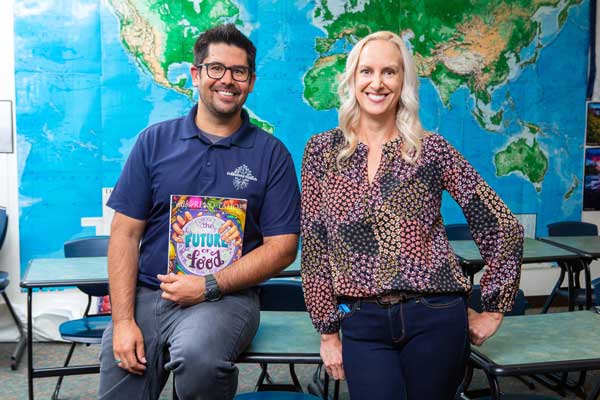UTURE OF FOOD 101
High school teachers bring edible to the classroom.
Written by Claire McArthur
Photo by Digiman Studio
Edible Reno-Tahoe has found its way from the magazine rack to the classroom thanks to the out-of-the-box thinking of one Reno teacher.
When Michael Lindberg saw the Summer 2018 edition of the magazine featuring the cover story The Future of Local Food, by writer Barbara Twitchell, he was intrigued.
“I teach an entire unit on agriculture in my AP Human Geography class, so I was really interested,” says Lindberg, who teaches the class to sophomores at Damonte Ranch High School in South Reno.
Twitchell’s piece takes a deep dive into the compelling innovations in food production, from high-tech indoor farming and agrihoods (neighborhoods built around community farms) to lab-grown meat and plant-based “burgers.” It highlights local leaders in sustainable agriculture and ranching, such as Bently Ranch in Minden and Dayton Valley Aquaponics in Dayton.
Teaching the text
Lindberg incorporated the article into his agriculture curriculum for the first time in the 2018-19 school year, with the help of teacher librarian Marcella Howden. In groups of four, the students each tackled a quarter of the article and summarized their findings for their peers.
“They work on their listening skills, ask questions, and have a discussion,” Lindberg explains. “There’s a lot of discussion on eating bugs and the various options for meat products that aren’t meat, like the Impossible Burger. We also talk about food waste and urban agriculture.”
To spur discussion in the class, Lindberg spins a digital wheel he created that contains questions about the article.
“For example, how do you feel about eating bugs? Is that too taboo for our society, or could you see yourself consuming bugs in the future if we need protein, but cows are too unsustainable?” Lindberg says.
The class even tried Chirps Chips made with cricket “flour.”
Preparing for the future
Twitchell said she was “truly thrilled” to learn that the story she put countless hours of research into was being used to educate the next generation.
“You can’t talk about the future of food without also discussing the myriad of challenges that the planet will be facing. Climate warming, population explosion, diminishing resources — these all will be major factors that’ll require us to change how and what we’ll eat in the future,” Twitchell says.
“This is a story about a reality that these students will face in their lifetimes,” she adds. “They can be part of the problem or part of the solution. Mr. Lindberg is giving them the information and the inspiration to make an informed choice regarding which they can choose to be.”
Making 15-year-olds aware of how their food choices affect the environment is important, Lindberg says.
“We’re teaching them at a young age that buying local is a really powerful way to limit your carbon footprint and support local businesses. Some are learning for the first time what an environmental disaster cows have become,” he says. “It’s about getting [the students] to understand that the choices they make have ripple effects in their local, national, and global world.”
Claire McArthur is a freelance writer who urges every one of you to hit the edible Reno-Tahoe online archives and read (or re-read!) The Future of Local Food in the Summer 2018 issue. It’s a thoroughly researched, well-written, and important story.
__________________
Barbara Twitchell’s The Future of Local Food feature, which was published in the Summer 2018 edition, won first place for a non-staff-written story at the Nevada Press Association awards ceremony on Sept. 21.
Reno illustrator Kate O’Hara also won third place in the Graphic Designer category for this article.


